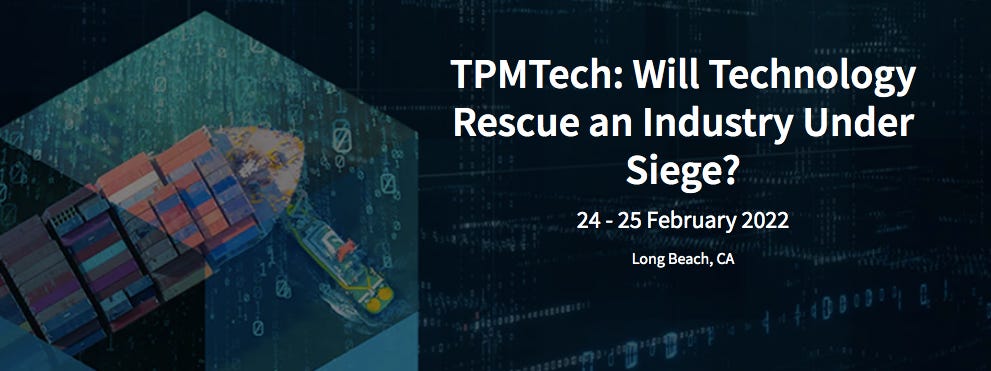Welcome to the 49th edition of The LogTech Letter, a weekly look at the impact technology is having on the world of global and domestic logistics. Last week, I discussed how logistics technology providers can define the experience of a new importer or exporter. This week, I delve into why logistics is inherently under-appreciated and why that aligns with the success of “under-the-hood” technology.
As a reminder, this is the place to turn on Fridays for quick reflection on a dynamic, software category, or specific company that’s on my mind. You’ll also find a collection of links to stories, videos and podcasts from me, my colleagues at the Journal of Commerce, and other analysis I find interesting.
For those that don’t know me, I’m Eric Johnson, senior technology editor at the Journal of Commerce and JOC.com. I can be reached at eric.johnson@ihsmarkit.com or on Twitter at @LogTechEric.
project44 has gotten a lot of attention this year (two acquisitions and two major funding rounds will do that) but indulge me in one more reference to the Chicago-based visibility provider as I try to build a point about logistics applications, plumbing, and scaling.
I’ll start off first by noting project44’s Twitter handle, which is not project44 or p44 or some direct reference to the company’s brand. Instead, it’s @freightpipes, which sounds more like the name of a logistics blog than the handle for a company with a $1 billion valuation. But that handle is actually pretty instructive, for a couple reasons. First, it came about during project44’s initial avatar, as a company building APIs to connect the freight industry – “freightpipes” was actually a more descriptive name at that point than a brand name that had to be explained.
But second, and more importantly, “freightpipes” is an apt descriptor for what really makes the logistics industry move. As companies, including project44, seek to build slick user interfaces, dashboards and consumer-grade applications, it’s important to remember that the plumbing is what makes logistics actually happen. Integrations between companies, regions, and systems, data feeds, web portals that unify buyers, sellers, suppliers, and customers. This is the nitty gritty of logistics that won’t ever go away.
In the first story I ever wrote about APIs (and project44) in October 2015, the title of the piece was “A New Communications Pipeline.” That pipe metaphor was good then and it remains good today.
This isn’t only a project44 story, by a long shot. In mid-July, Freightos’ Eytan Buchman asked me what the major themes in freight technology were this year, and then what the major themes should be. Here’s a synopsis of what I told him:
“I’m personally partial to the out-of-sight stuff. As much as we want to make shipping and logistics more glamorous - it’s our time in the sun! - the reality of this business is it’s a lot of drudge work and unglamorous things. And there’s a parallel stream of really important, but unglamorous stuff like system integration work and data normalization work and RPA work. That stuff is hugely important and ultimately more important than a slick map.”
It’s true that there has historically been a deficit of good online user experiences in logistics, and that much of the technology focused on the space has rightly focused on improving that UX. But we can’t ignore that logistics is not a one-click environment (sorry for the double negative – this is why editors are a good thing). It’s messy and unkempt, like a teenager’s bedroom. Most of the organization enabled by technology is doing superficial things like making the bed, putting clothes in the dresser and shoving toys into the closet.
And that’s okay. A teenager’s room shouldn’t look staged like it’s in a home furnishings catalog, just as a logistics organization will never have everything humming along perfectly 24/7. The technology should work for the user under the constraints in which that user exists. A teenager ought not be obsessively neat, and logistics managers should not expect that technology will make their job feel like a meditation session.
As technology providers in the space think about what their solutions do, for the organization and the individual user, it’s important to keep in mind that logistics people are generally not inclined to be the types who beat their chests. One logistics director for a major international food shipper told me this week “it’s nice that supply chain is getting attention, but I sort of miss the mostly anonymous life I used to have.”
I think about that idea, along with what forwarders have told my colleagues and I about for years – that there’s a certain percentage of global logistics that is virtually non-automatable. Whether that percentage is 20 percent or 80 percent is up for debate, and actually pretty hard to quantify. But the underlying message is that systems aren’t yet optimized to untangle the messy nature of logistics.
A new house is only as good as its foundations, and the water pressure is only as good as the pipes. Logistics solutions are only as good as the grimy integrations that enable them to talk to one another, allowing data to be collected, shared and utilized like a set of bathrooms using a common source of water. Turns out, @freightpipes was a pretty prescient moniker after all.
🚨LogTech Market Map update
Two week ago, we released v1 of our LogTech Market Map, and we’ve gathered a ton of feedback and new companies to include the next version, which we’ll be coming out with soon. Thanks to everyone who has shared this around and given us their thoughts. Still time to register your company with us via this link.
🚨TPMTech is coming to Long Beach Feb. 24-25!
This week we launched the theme for TPMTech. Check back frequently for updates on speakers, sessions and other things we’ll be adding to the mix. Registration for both TPMTech and TPM22 will open Aug. 2.
Here’s a roundup of pieces on JOC.com the past week from my colleagues and myself (note: there is a paywall):
Biggest news this week is obviously Uber Freight’s $2.5B acquisition of freight broker and managed transportation services provider Transplace. A lot of different dimensions to explore, most notably how this affects Uber’s positioning with customers. Adding Transplace’s customer list and freight under management instantly builds credibility, in addition to its foray into LTL through a partnership with Blue Grace Logistics announced last week. In short, do we need to stop thinking about Uber Freight as a “digital broker” now? Its parent selling off a chunk of the brokerage business to Greenbriar (which formerly owned Transplace) in October was one sign it would be taking a slower path to legitimacy than most had presumed.
The Global Shipping Business Network has existed somewhat in the shadow of two other organizations attempting to accomplish similar goals – digitizing and standardizing data flow in the liner business. This week, the GSBN launched a new product aimed at using blockchain - remember that? – to expedite cargo release at ports in China. The company said it expects to expand to other regions later in 2021.
One of those other organizations is the Digital Container Shipping Association, which this week went deeper in prescribing specific messages that terminals and container vessel operators should exchange around port calls to optimize berth space, yard space and resources in the terminal. This stuff is extremely nuanced, super nerdy, and hence why I love it.
EDRAY has been on the scene for a few years now, founded by ex-Home Depot supply chain exec Reade Kidd. It announced an expansion of its platform this week – from what it calls “flow stacks” to a wide range of drayage and destination management services – as well as an infusion of capital from Andrew Leto, famous for founding Emerge, GlobalTranz and 10-4 Systems.
One of the most gratifying parts of my job is hearing from founders who mention a story I wrote, or a session I moderated, or even an entire program I put together, as being an inspiration for them in building their own companies. Our LogTech conference in Las Vegas has been an inspiration for many founders in that regard. Two years ago, I convened a small technology summit in Mumbai to discuss the fast evolving logistics market in India, and one of the attendees at that summit was Neelam Choudhary, a logistics veteran in India and now a co-founder of Transpost. Last week, Transpost came out of stealth, launching as a platform to serve SME forwarders and customs brokers in India, and possibly beyond.
And here are some recent discussions, reports, and analysis I found interesting:
Fascinating look at the coming rise of the secondhand market for goods.
I have some thoughts about this…in fact, I already wrote about this here.
Not at all logistics-related, but here’s a great thread on why someone who is not vaccinated may not be anti-vax, and the care we need to show in such circumstances. Much of our current environment is more binary than people like to make it out to be, but that still leaves a lot of room for gray areas.
If you care about inclusivity in logistics, you need to listen to this podcast. If you don’t care inclusivity, then you really need to listen to it.
Love this tweet, showing something I talk about all the time in logistics, that there is no “center of the investment world” because of how diffuse the business of moving goods is.
Some upcoming events I’ll be involved in:
My new monthly show on the Let’s Talk Supply Chain network premieres 10 am EST Aug. 6. It’s called LogTech Live and our first guest is Rachel Premack, intrepid reporter at Business Insider. I’ll be discussing tech topics of the day, which buzzwords are meaningful or not, with a healthy sprinkling of dadjokes. Count on it being fun and informative.
Disclaimer: This newsletter is in no way affiliated with The Journal of Commerce or IHS Markit, and any opinions are mine only.









congrats on the new show man!
Eric Johnson--very well written as usual. We agree the plumbing is foundational. We feel we are the "Intel inside" for the supply chain industry providing high fidelity real time data to help clients deliver better outcomes. John Fitzgerald